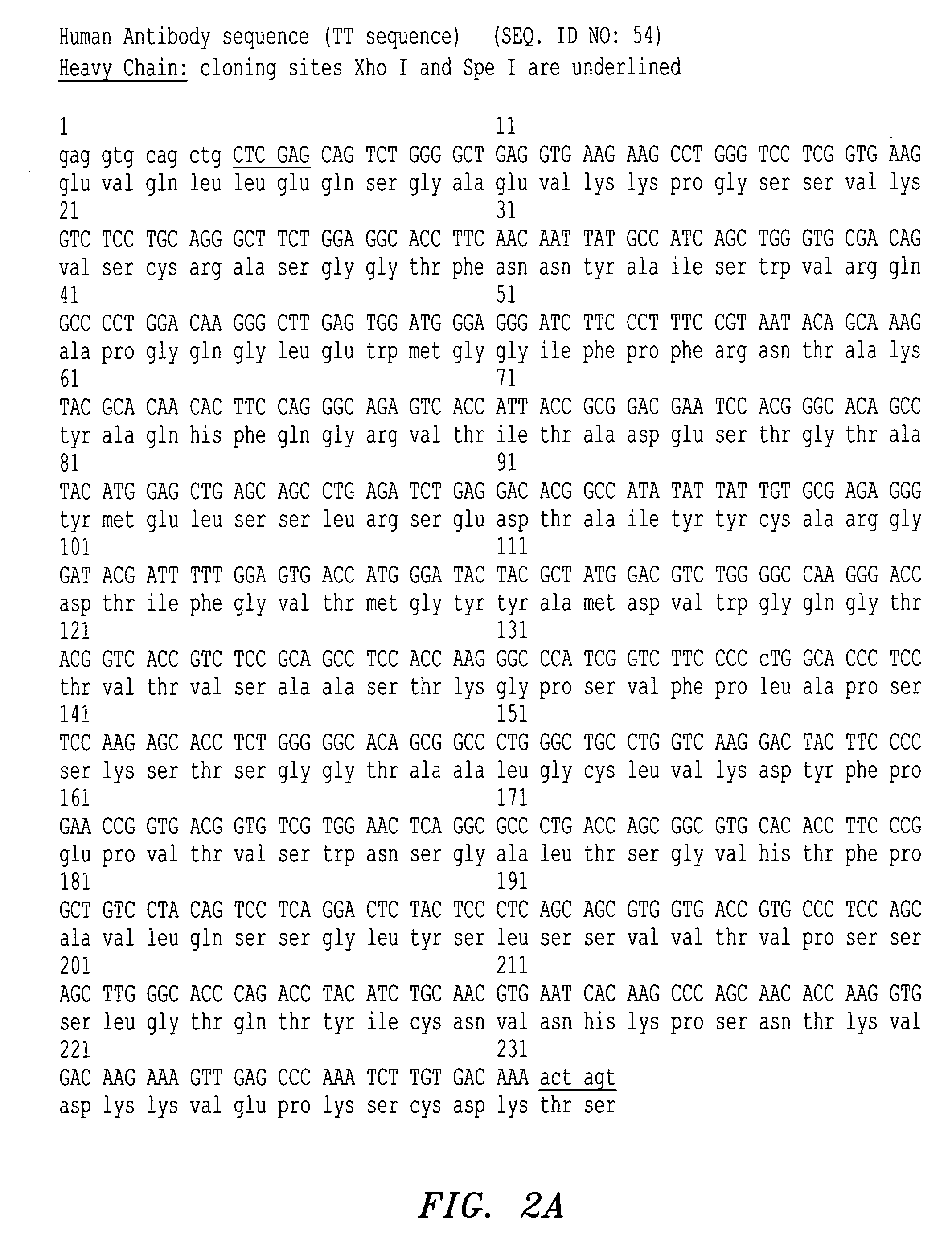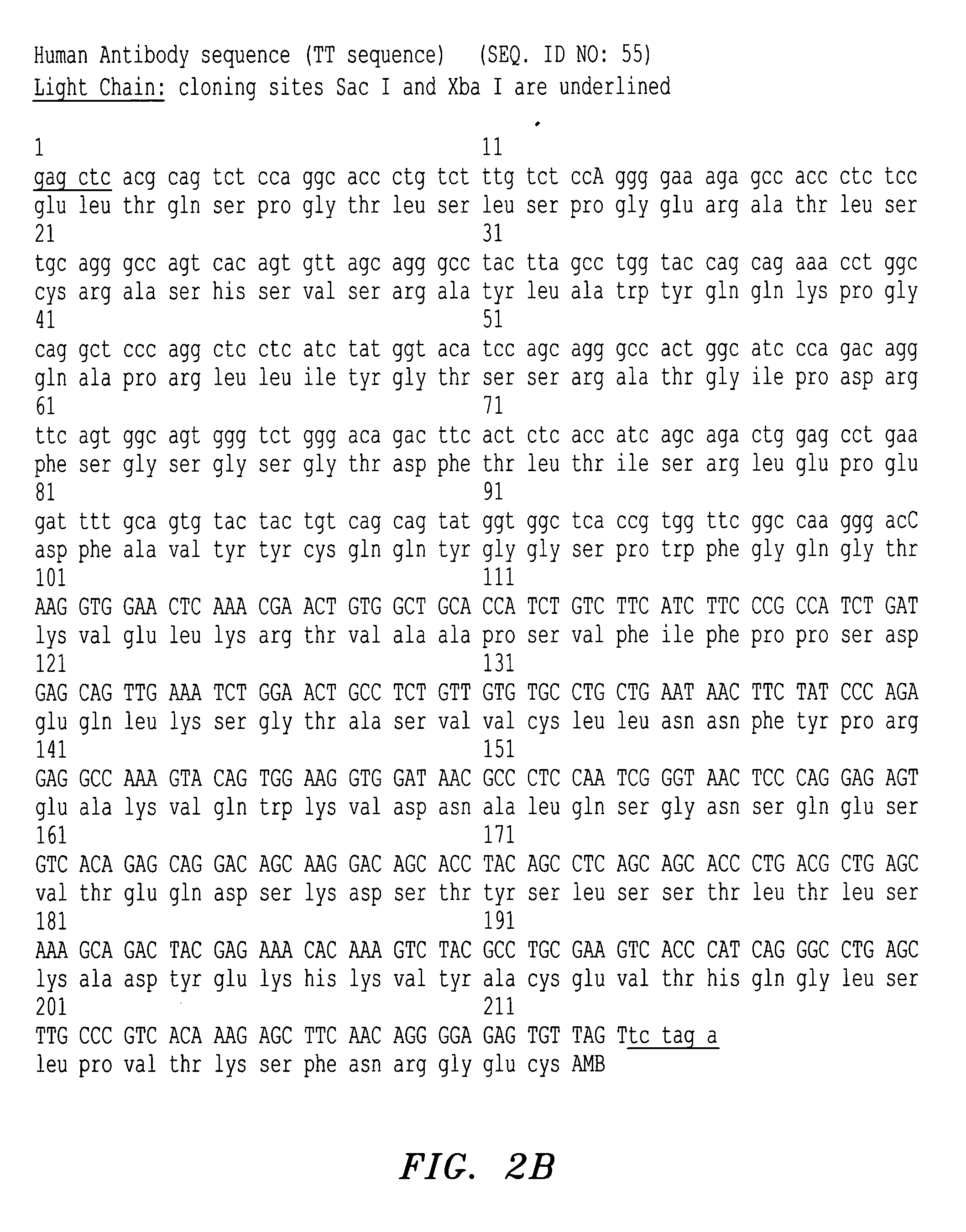Rationally designed antibodies
a technology of antibodies and antibodies, applied in the field of rational design of antibodies, can solve the problems of difficult to predict the activity, therapeutic or otherwise, of peptides, and the unsatisfactory effect of peptides as therapeutics
- Summary
- Abstract
- Description
- Claims
- Application Information
AI Technical Summary
Benefits of technology
Problems solved by technology
Method used
Image
Examples
example 1
Library Construction Of TPO Mimetic Sequences Grafted Into A Human Antibody Framework
[0201] An agonist TPO mimetic-peptide IEGPTLRQWLAARA (SEQ. ID. NO: 1) was grafted into the anti-tetanus toxoid (TT) Fab heavy chain CDR3 (HCDR3), replacing the entire HCDR3 sequence GDTIFGVTMGYYAMDV (SEQ. ID. NO: 4). FIG. 2A shows the sequence for the human tetanus toxoid antibody employed. Two grafting approaches were taken. In the first approach the agonist peptide was inserted into the H-CDR3 region with two glycines flanking each side. This was to reduce structural constraints on the grafted peptide so that it could more easily adopt the needed conformation. In the second approach, two amino acid positions on each side of the peptide graft were randomized in order that the best presentation of the peptide could be achieved (FIG. 3). These two approaches were taken in order to determine whether the peptide alone was sufficient or if specific residues were required for proper presentation of the a...
example 2
Additional Libraries Containing TPO Mimetic Sequences Grafted Into A Human Antibody Framework
[0216] Another approach to linking two agonistic peptides together in an antibody framework is to insert the agonist peptide in more than one position within a single Fab fragment. In order to do that, additional libraries containing TPO mimetic sequences grafted into a human antibody framework were constructed. Following selection of peptides properly presented in the context of CDR1, CDR2 or CDR3 of the light chain, or CDR2 of the heavy chain, the binding sequences were combined into a single Fab molecule, for example as listed in Table 1 below, and analyzed for enhanced activity.
5 TABLE 1 Peptide 1 Peptide 2 H-CDR3 H-CDR2 H-CDR3 L-CDR1 H-CDR3 L-CDR2 H-CDR3 L-CDR3 H-CDR2 L-CDR2 H-CDR2 L-CDR3 L-CDR3 L-CDR2
[0217] Four additional libraries have been constructed separately replacing the heavy chain CDR2 as well as the light chain CDR1, CDR2 and CDR3 with the TPO mimetic peptide flanked by 2 ra...
example 3
[0226] Combinations of the TPO mimetic peptide grafted Fab clones from FIG. 9 have been generated. Thus a single antibody might contain multiple copies of the TPO mimetic peptide within a single light or heavy chain. Alternatively, both the light and heavy chains might contain peptide grafts giving multiple copies within a single Fab. Positive clones selected from the same CDR library were pooled. New libraries were constructed by combining the pool of one TPO mimetic peptide containing CDR with the pool of another. Combinations where one of the TPO mimetic peptides is in the light chain and the other is in the heavy chain are made using simple cloning techniques using the pooled plasmid DNAs, and the unique restriction sites flanking the heavy (Xho I-Spel) and light chains (Sac I-Xba I). For example, the plasmid DNA for the H-CDR3 peptide grafted heavy chains were combined and digested by Xho I and Spe I. The purified heavy chain inserts were ligated into the Xho I / Spe I digested p...
PUM
| Property | Measurement | Unit |
|---|---|---|
| temperature | aaaaa | aaaaa |
| volume | aaaaa | aaaaa |
| pH | aaaaa | aaaaa |
Abstract
Description
Claims
Application Information
 Login to View More
Login to View More - R&D
- Intellectual Property
- Life Sciences
- Materials
- Tech Scout
- Unparalleled Data Quality
- Higher Quality Content
- 60% Fewer Hallucinations
Browse by: Latest US Patents, China's latest patents, Technical Efficacy Thesaurus, Application Domain, Technology Topic, Popular Technical Reports.
© 2025 PatSnap. All rights reserved.Legal|Privacy policy|Modern Slavery Act Transparency Statement|Sitemap|About US| Contact US: help@patsnap.com



